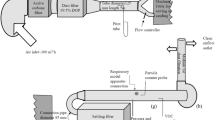Abstract
Hardwood dust is a human carcinogen; upon inhalation, it can cause sinonasal adenocarcinoma. Softwood, on the other hand, is only suspected of carcinogenic properties. However, the toxicology-based recommended exposure limits for hardwood and softwood dust in working environments have been derived identically. While it is very simple to distinguish the wood by morphological evaluations, the wood dust produced in working activities does not allow differentiation. Thermal analysis, especially thermogravimetry, was applied to evaluate the different characteristic thermal profile of standard hardwood and softwood dusts. The different TG and DTG traces allow to propose thermogravimetry as a new tool to distinguish and quantify the different dust origin.







Similar content being viewed by others
References
IARC. Wood dust. IARC Monogr Eval Carcinog Risks Hum. 1995;62:35–215.
Mazzoli A, Favoni O. Particle size, size distribution and morphological evaluation of airborne dust particles of diverse woods by scanning electron microscopy and image processing program. Powder Technol. 2012;225:65–71.
Bornholdt J, Saber AT, Sharma AK, Savolainen K, Vogel U, Wallin H. Inflammatory response and genotoxicity of seven wood dusts in the human epithelial cell line A549. Mutat Res. 2007;632:78–488.
Vinzents PS, Schlünssen V, Feveile H, Schaumburg I. Variations in exposure to inhalable wood dust in the Danish furniture industry. Within- and between-worker and factory components estimated from passive dust sampling. Ann Occup Hyg. 2001;45:603–8.
Thorpe A, Brown RC. Factors influencing the production of dust during the sanding of wood. J Aerosol Sci. 1992;23:237–40.
Schlünssen V, Vinzents PS, Mikkelsen AB, Schaumburg I. Wood dust exposure in the Danish furniture industry using conventional and passive monitors. Ann Occup Hyg. 2001;45:157–64.
Pylkkänen L, Stockmann-Juvala H, Alenius H, Husgafvel-Pursiainen K, Savolainen K. Wood dusts induce the production of reactive oxygen species and caspase-3 activity in human bronchial epithelial cells. Toxicology. 2009;262:265–70.
Pérez-Escuredo J, García Martínez J, Vivanco B, Álvarez Marcos C, Suárez C, Llorente JL, Hermsen MA. Wood dust-related mutational profile of TP53 in intestinal-type sinonasal adenocarcinoma. Hum Pathol. 2012. doi:10.1016/j.humpath.2012.01.016.
Meszaros E, Jakab E, Varhegyi G, Szepesvary P, Marosvolgyi B. Comparative study of the thermal behavior of wood and bark of young shoots obtained from an energy plantation. J Anal Appl Pyrolysis. 2004;72:317–28.
Jakab E, Faix O, Till F. Thermal decomposition of milled wood lignins studied by thermogravimetry/mass spectrometry. J Anal Appl Pyrolysis. 1997;40:171–86.
Zeriouh A, Belkbir L. Dilatometry analysis of Moroccan acacia wood under a nitrogen atmosphere. Thermochim Acta. 1996;287:293–8.
Vecchio S, Luciano G, Franceschi E. Explorative kinetic study on the thermal degradation of five wood species for applications in the archaeological field. Ann Chim. 2006;96:715–25.
Materazzi S, Vecchio S, Wo LW, De Angelis Curtis S. TG–MS and TG–FTIR studies of imidazole-substituted coordination compounds: Co(II) and Ni(II)-complexes of bis(1-methylimidazol-2-yl)ketone. Thermochim Acta. 2012;543:183–7.
Materazzi S, Kurdziel K, Tentolini U, Bacaloni A, Aquili S. Thermal stability and decomposition mechanism of 1-allylimidazole coordination compounds: a TG–FTIR study of Co(II), Ni(II) and Cu(II) hexacoordinate complexes. Thermochim Acta. 2003;395:133–7.
Materazzi S, D’Ascenzo G, Aquili S, Kadish KM, Bear JL. Thermoanalytical characterization of solid-state Co(II)–Ni(II)- and Cu(II)-4(5)-aminoimidazole-5(4)-carboxamide complexes. Thermochim Acta. 2003;397:129–34.
Materazzi S, Aquili S, De Angelis Curtis S, Bianchetti C, D’Ascenzo G, Kadish KM, Bear JL. The decomposition mechanism of new solid-state 4(5)-aminoimidazole-5(4)-carboxamide coordination compounds. Thermochim Acta. 2004;409:145–50.
Materazzi S, Aquili S, De Angelis Curtis S, Vecchio S, Kurdziel K, Sagone F. Biomimetic complexes: thermal stability kinetic study and decomposition mechanism of Co(II)-, Ni(II)- and Cu(II)-4(5)-hydroxymethyl-5(4)-methylimidazole complexes. Thermochim Acta. 2004;421:19–24.
Materazzi S, Aquili S, Kurdziel K, Vecchio S. Biomimetic polyimidazole complexes: a thermoanalytical study of Co(II)–NI(II)- and Cu(II)-bis(imidazol-2-yl)methane complexes. Thermochim Acta. 2007;457:7–10.
De Angelis Curtis S, Kurdziel K, Materazzi S, Vecchio S. Crystal structure and thermoanalytical study of a manganese(II) complex with 1-allylimidazole. J Therm Anal Calorim. 2008;92:109–14.
Materazzi S, Gentili A, Curini R. Application of evolved gas analysis. Part 1: EGA by infrared spectroscopy. Talanta. 2006;68:489–96.
Materazzi S, Vecchio S. Evolved gas analysis by infrared spectroscopy. Appl Spectrosc Rev. 2010;45:241–73.
Materazzi S, Gentili A, Curini R. Application of evolved gas analysis. Part2: EGA by mass spectrometry. Talanta. 2006;69:781–94.
Materazzi S, Vecchio S. Evolved gas analysis by mass spectrometry. Appl Spectrosc Rev. 2011;46:261–340.
Materazzi S, Vecchio S, Wo LW, De Angelis Curtis S. Thermoanalytical studies of imidazole-substituted coordination compounds. Mn(II) complexes of bis(1-methylimidazol-2yl)ketone. J Therm Anal Calorim. 2011;103:59–64.
Materazzi S, Curini R. The coupling of mass spectrometry with thermoanalytical instruments: applications of evolved gas analysis. Appl Spectrosc Rev. 2001;36:169–80.
Materazzi S, Curini R. On-line evolved gas analysis by infrared spectroscopy coupled to thermoanalytical instruments. Appl Spectrosc Rev. 2001;36:1–9.
Materazzi S. Mass spectrometry coupled to thermogravimetry (TG-MS) for evolved gas characterization: a review. Appl Spectrosc Rev. 1998;33:189–97.
Materazzi S. Thermogravimetry–infrared spectroscopy (TG–FTIR) coupled analysis. Appl Spectrosc Rev. 1997;32:385–97.
Perrino C, Canepari S, Materazzi S. Thermal stability of inorganic and organic compounds in atmospheric particulate matter. Atmos Environ. 2012;54:36–43.
Vecchio S, Di Rocco R, Ferragina C, Materazzi S. Thermal and kinetic study of dehydration and decomposition processes for copper complex intercalated in γ-zirconium and γ-titanium phosphates. Thermochim Acta. 2005;435:181–7.
Author information
Authors and Affiliations
Corresponding author
Rights and permissions
About this article
Cite this article
Materazzi, S., Vecchio, S. & De Angelis Curtis, S. Thermal analysis and health safety. J Therm Anal Calorim 112, 529–533 (2013). https://doi.org/10.1007/s10973-012-2762-z
Received:
Accepted:
Published:
Issue Date:
DOI: https://doi.org/10.1007/s10973-012-2762-z




